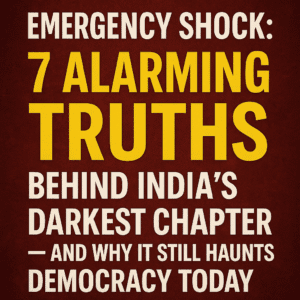Emergency Shock: 7 Alarming Truths Behind India’s Darkest Chapter—and Why It Still Haunts Democracy Today
The Union Cabinet’s resolution marking 50 years since India’s 1975 Emergency confronts one of democracy’s darkest periods—when constitutional rights were suspended, dissent crushed, and federalism undermined. By honoring ordinary citizens who resisted authoritarianism, it transforms historical memory into a living lesson: democracies thrive only through constant vigilance. The move carries contemporary weight, framing today’s political debates about institutional integrity while challenging younger generations to understand how easily freedoms erode. Beyond partisan narratives, the commemoration underscores universal truths—that constitutions are protected not by institutions alone, but by citizens’ courage to defend them. Its enduring relevance lies in reminding India that safeguarding liberty requires recognizing tyranny’s warning signs, always.

Emergency Shock: 7 Alarming Truths Behind India’s Darkest Chapter—and Why It Still Haunts Democracy Today
Fifty years after Indira Gandhi’s government suspended civil liberties in a 21-month period now etched into India’s consciousness as “The Emergency,” the Union Cabinet’s resolution to formally commemorate its anniversary transcends political symbolism. It forces a national reckoning with questions every democracy must periodically ask itself: What makes our freedoms fragile? And who truly defends them?
Beyond Political Tributes: Unpacking the Cabinet’s Resolution
The Modi government’s declaration of June 25 as “Samvidhan Hatya Diwas” (Constitution Murder Day) goes beyond honoring victims. It frames the Emergency as:
- A systemic collapse where federalism, fundamental rights, and judicial independence were dismantled
- A cautionary tale about unchecked power – relevant in an era of global democratic backsliding
- A tribute to ordinary citizens (journalists, students, activists) whose resistance kept constitutional ideals alive
The Unspoken Parallels in Today’s Politics
While the resolution explicitly targets the Congress’ historical role, JP Nadda’s accusation that Congress retains an “Emergency mindset” reveals a deeper narrative battle. The BJP positions itself as the guardian of democratic resilience, contrasting its origins in the anti-Emergency movement with Congress’ alleged authoritarian legacy. Yet critics argue this distracts from contemporary debates about institutional independence and dissent – showing how historical trauma remains a live political weapon.
Why Young Indians Should Care
The Cabinet’s call for youth to “draw inspiration” from Emergency resistors highlights a generational disconnect. For under-40 Indians:
- This isn’t ancient history: The structures tested then (free press, judicial review, federal balance) protect their rights today
- The horror wasn’t just arrests, but normalization of tyranny: Censored newspapers, silenced opposition, propaganda
- As PM Modi noted, his own political awakening came through anti-Emergency activism – proving individual courage sparks change
The Unfinished Reconciliation
Notably absent? Any Congress apology for the Emergency. This unresolved accountability fuels today’s political rancor. When Rahul Gandhi accuses the BJP of “constitutional disrespect,” the BJP counters with 1975 – trapping both parties in a cycle of mutual recrimination that obscures bipartisan constitutional stewardship.
You must be logged in to post a comment.